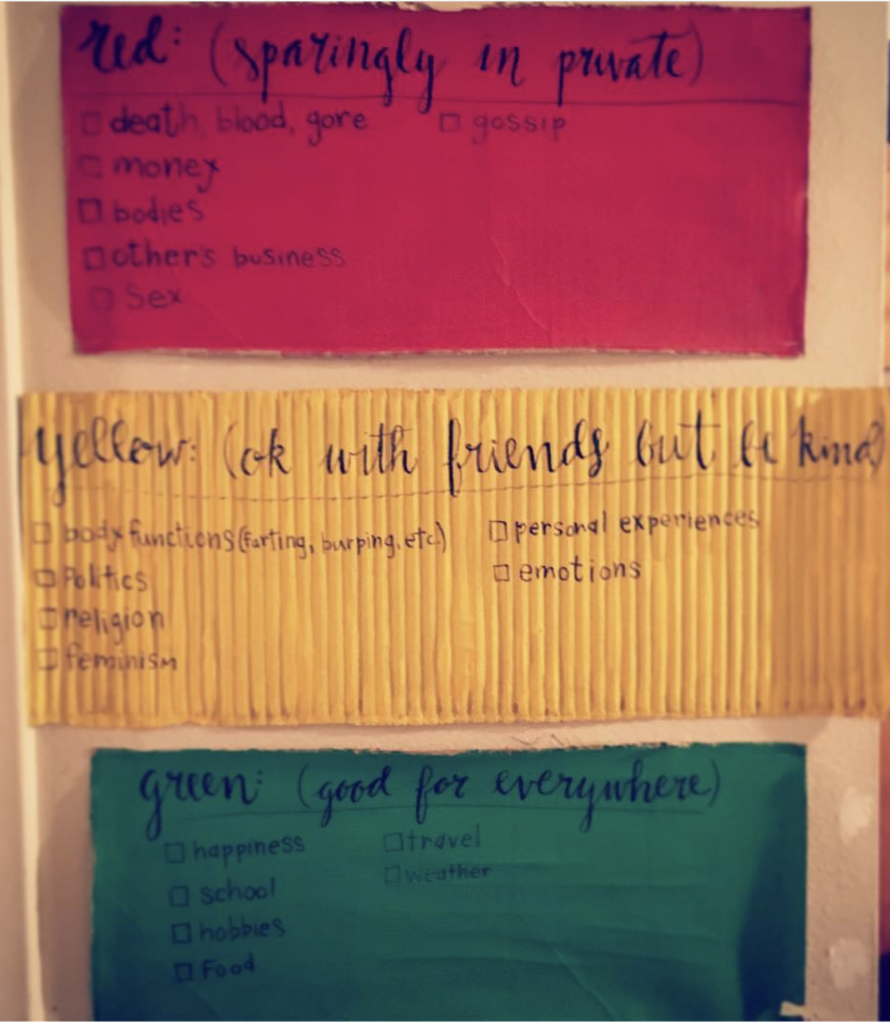When my children were young, we had three boards on the wall. Each board represented specific social expectations for different settings.
- Green: Personal space bubble of at least a handshake away. Good for everywhere. Conversation topics: The weather, happiness, school, travel, food, and hobbies.
- Yellow: Personal space bubble of about a high-five distance. Good for family and friends if you remember to be kind. Conversation topics: politics, religion, farting, burping, emotions, and personal experiences.
- Red: Personal space bubble of a hug. Use sparingly and in private. Conversation topics: money, other people’s business, sex, blood, and guts.
My son has autism spectrum disorder, and social norms do not come naturally to him. When I say “doesn’t come naturally,” I don’t want you to think:

“Hitting the ball didn’t come naturally to him.”
It’s more on the level with:
“Eating didn’t come naturally to him.”
Three Parts of a Person
For the purposes of this article, let us say that there are three aspects of every person—Involuntary Processes (breathing), Voluntary Control (swinging a bat), and Social Functioning (understanding social situations).
The average person typically grasps these three things effortlessly, often without conscious awareness.
Whether it is walking, talking, reading, or writing, there are standard milestones everyone can anticipate their child achieving, not just from a time-frame perspective but also from the level of skill. It is not merely that a child utters their first word around 18 months, but that by 2, that child should have 50 words or more. If these milestones are not met—we call the doctors to assess the situation.
When my son was a baby, he would avoid certain words because–on a physical and chemical level–the vibration of the words in his mouth caused him distress. For him, it seemed to be the sounds that required him to press his tongue onto the roof of his mouth—T, D, J, N.
This, along with other indicators such as his limited engagement in appropriate play with toys, or his propensity for only walking on his tiptoes, were the first indicators that his social function was not developing in a standardized manner. Doctors were called in to assess the situation.
We call autism spectrum disorder my son’s superpower. He sees and feels on a level that most people will never comprehend. He loves more purely than anyone. He is confused by unkindness. He trusts implicitly and without reservation.
Autism Spectrum Disorder
But just as with any superpower, my son’s has its Kryptonite.
Individuals with autism can experience such elevated stress levels that it is often misdiagnosed as PTSD. A child with autism lives with a mind so constantly on hyper-drive that it often fails to interpret basic social cues. Some of the more common traits for those with autism include:
- Challenges in understanding and responding to social cues and nonverbal communication, such as body language and facial expression.
- Difficulty initiating and sustaining conversations.
- Struggles with reciprocal social interactions and understanding others’ emotions, interests, or needs.
- Inability to interpret and predict the thoughts and intentions of others.
- Hypersensitivity to sounds, lights, textures, or smells impacts their ability to engage in social environments.
My son’s mind ‘SHOUTS’ at him on a minute-by-minute basis, and because of this, he struggles with what most of us would consider fundamental human interactions. To compound this already delicate balance, my son also has prosopagnosia, or ‘face-blindness.’ The inability or difficulty in recognizing and distinguishing facial expressions. Social interactions did not come naturally in our home, so I taught them as basics as one would teach a baby to walk. In the autism world, we teach these with ‘social stories.’
A social story explains social situations to autistic children to help them learn ways of behaving in various situations. These stories are sometimes called social scripts.

Social Stories:
Here’s an example:
Jane is on the ground holding her knee and crying. From the situation, we can make certain assumptions. Jane has fallen. Jane has hurt her knee. Jane is in pain. You should go over to Jane and ask her if she is ok, but do not touch her without permission. If she permits you, remember to softly touch her but only on the shoulder. You can ask her if she is ok but also remember to keep your voice at a level comfortable for speaking nearby. Do not shout.
EVERY SINGLE moment of my son’s life had to be broken down in this manner, and because my son is the second of four children, as a single mother, it was much easier to raise all my children to all analyze situations in this manner.
The result? Communication and socialization are VERY different in our household.
Everyone with a family member with ASD understands that metaphors, sarcasm, and even dishonesty are complex concepts to teach. Have you ever tried to explain why it’s not ok to lie? Like, ACTUALLY explain it?
Why is lying wrong?
What is the absolute most basic—none-morally based—reason for honesty? And why do we sometimes not tell the truth?
There was no space in my home for phrases like:
“I brought you into this world, and I can take you out,” or “I dare you to say that again.”
I was busy explaining that:
- “Give me just a minute” does not actually mean 60 seconds.
- It is not, in fact, funny to shout “bomb!” in the middle of the airport.
- Telling your teacher that you don’t care what she thinks is unacceptable—no matter how true.
While most people were taking their sons to play catch, I was teaching mine that meeting people started with a smile and a wave. My motherhood journey is the best one anyone has ever had.
Recently my now 20-year-old son moved across the country for a summer job in pest control.
About a week after he left, he called me in a panic.
“Mom. They moved my rooms, and the place I’m moving to has two people living there, and they aren’t home. I’m so stressed out.”
“Ok, my love, where are you now,” I said over the phone.
“In my car. I left my stuff there, and I wrote my phone number on a piece of paper. I’m waiting for them to text me.”
I paused to assess his words, “Baby…Did you say anything else on the note?”
“No.”
“Ok. So, typically, leaving your phone number on a piece of paper on the kitchen counter doesn’t convey that you are waiting for someone to text you. You’re going to have to go inside.”
“But it’s too much. I don’t know them, and now I’m in their space.”
“Ok. So, this happens to everyone, and it makes everyone uncomfortable. No one likes being next to people that they don’t know. That feeling goes away after a little while, though. Remember, it’s just your mind forming new connections and using many chemicals to do so. That feeling is called discomfort. Also, people have ways that they handle these situations.”
“Like what?”
“Well, you can: Walk into the room, reach your hand out for a shake, and say, ‘Hello, I’m your new roommate. What is your name?’ another way to work with a social situation is to bring a gift—maybe a box of donuts or a pepperoni pizza. People bring gifts to uncomfortable situations all the time. It helps because you have an object between the two of you that you are offering to the other person, and by doing so, you are connecting yourselves together.”
He paused, “Oh. But what if they don’t like pizza? What if I buy it and they don’t like it?”
“Ok, then, what you can do is both. You can walk in and say, ‘Hi, I’m your new roommate. I was going to order some pizza. Does anyone want some?”
After half an hour on the phone, my son calmed down and decided on option A. He also understood that if option A didn’t work, he could choose option B. We used a social script to overcome an uncomfortable situation.
Scripting is not manipulation.
Scripting is as essential to you and me as breathing or walking. We don’t know it because we learned it while learning to breathe and walk. We have been using scripting since we came out of the womb and were rewarded for our first scream. But just because something comes naturally doesn’t mean it cannot be improved.
In 2002, Tanya Streeter held her breath for 3 minutes and 38 seconds as she dove 525 ft under the water to achieve the free-diving world record. To succeed in this accomplishment, Tanya had to teach her body to breathe in just enough air to fill her lungs without pinching the blood flow to her heart. She used a method called lung-packing to maximize the amount of air stored and potentially provide her with an additional few seconds underwater. Packing is a highly advanced skill utilized for a very specific sport. To learn how to do this, Tanya had to first become conscious of her natural breathing rhythms and then how to expand those rhythms to allow her to succeed at peak performance. In her Ted-Talk, she describes how she could potentially black out and die if she took in “too much” air.
Tanya used a ‘script’ to improve her breathing.
My son uses ‘scripts’ to improve his social skills.
Can you use ‘scripts’ to improve your communication?
Here’s a test:
- When you pull up to the drive-through at Mcdonald’s, Burger King, or Chic-Fil-a—what do they say?
- How much time do you have to answer before it gets awkward?
- If you have to take longer than that amount of time, what do you say?
When my family goes to grab some fast food, our encounters play out a little differently (note: this is not an exaggerated conversation):
Cashier: “Good morning. My name is Jacob; how can I take your order?
My son: “Hello! Good sir! And a fine morning it is! How are you today!?
Cashier: “I’m good. How can I take your order?”
My son [laughing]: “I would like 50 lbs of chicken nuggets and 200 lbs of French Fries. RIGHT NOW!”
Cashier [laughs awkwardly]
My son [still laughing]: “Joking. Joking. Can I have a number 2, please?”
Application
In a recent podcast episode, Herb and I had an enthusiastic conversation about the framework of a sale, and the question was raised:
- Are the steps to the sale an antiquated technique?
- Are the steps to the sale a form of manipulation?
I say no.
The steps to the sale are a social story. When we look at them in this manner, we can see how their implementation and practice of them will allow us the capacity to dive deep into a conversation and fully understand the needs of our customers. However, we must also remember that in any situation—too much is too much, and we can ‘black out’ if not used properly.
Let’s use them in a non-car sale situation.
- Hi! My name is Charity. (Meet and Greet)
- What’s your name? (Discovery)
- What are you at University to study? (Wants and Needs Assessment)
- Me too! I think sociology is fascinating, especially the class led by Dr. Bab. (Presentation)
- Are you taking any other classes? Maybe we have more crossovers. (Trial Close)
- OH! I took statistics last semester; if you need it, I could help with that. I need help in Business Admin. (Trade Evaluation)
- Would you be interested in studying together? (Presenting numbers)
- Would Friday or Saturday work? (Negotiation)
- Perfect! Let’s plan for Saturday at noon. (Commitment)
- This is my friend, Alice; she would be a great addition to our study team. (TO)
- *Group meets to study* (Delivery)
- *Group stays in contact for future study sessions.* (Follow-Up)
It may be because of the twenty years of breaking down every single situation to the macro that has created a hyper-sensitivity to communication. Still, I have never felt the steps to the sale were manipulative. Nor do I think they are antiquated or bad-form. The steps to the sales are simply the structure that allows our newest employees to become conscious of the breath of a conversation. There is no tactic to lure unsuspecting consumers into our buildings. The steps to the sale are the steps of a conversation. They can be utilized in nearly any situation. This is not manipulation. It is the awakening of the mind.
Charity Ann/Herb Anderson




